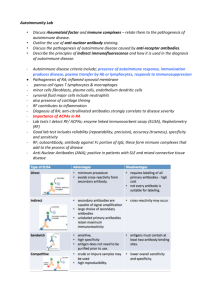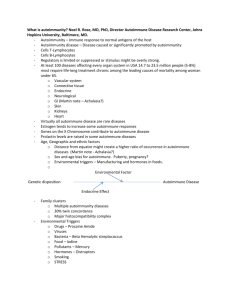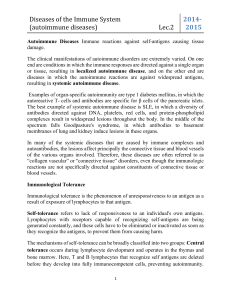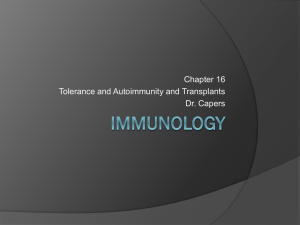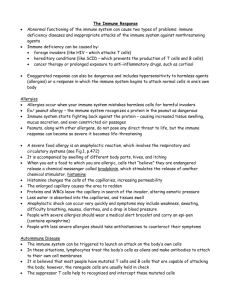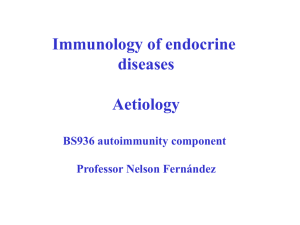Information on Auto Immune Diseases By Kelly Norman on Tuesday
advertisement
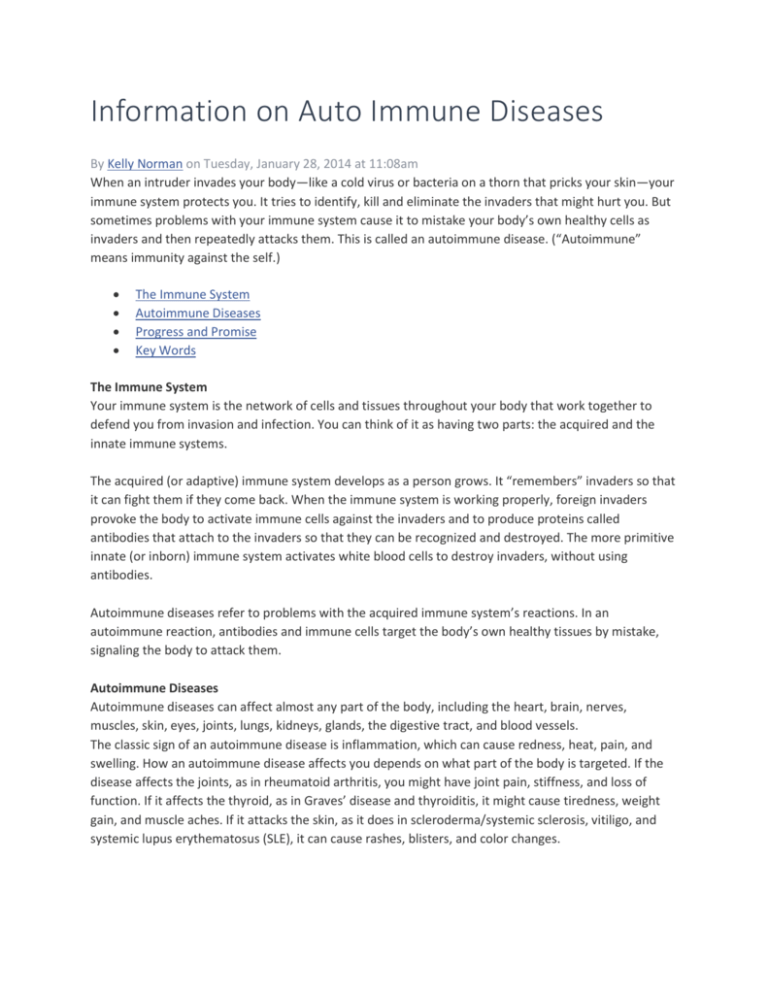
Information on Auto Immune Diseases By Kelly Norman on Tuesday, January 28, 2014 at 11:08am When an intruder invades your body—like a cold virus or bacteria on a thorn that pricks your skin—your immune system protects you. It tries to identify, kill and eliminate the invaders that might hurt you. But sometimes problems with your immune system cause it to mistake your body’s own healthy cells as invaders and then repeatedly attacks them. This is called an autoimmune disease. (“Autoimmune” means immunity against the self.) The Immune System Autoimmune Diseases Progress and Promise Key Words The Immune System Your immune system is the network of cells and tissues throughout your body that work together to defend you from invasion and infection. You can think of it as having two parts: the acquired and the innate immune systems. The acquired (or adaptive) immune system develops as a person grows. It “remembers” invaders so that it can fight them if they come back. When the immune system is working properly, foreign invaders provoke the body to activate immune cells against the invaders and to produce proteins called antibodies that attach to the invaders so that they can be recognized and destroyed. The more primitive innate (or inborn) immune system activates white blood cells to destroy invaders, without using antibodies. Autoimmune diseases refer to problems with the acquired immune system’s reactions. In an autoimmune reaction, antibodies and immune cells target the body’s own healthy tissues by mistake, signaling the body to attack them. Autoimmune Diseases Autoimmune diseases can affect almost any part of the body, including the heart, brain, nerves, muscles, skin, eyes, joints, lungs, kidneys, glands, the digestive tract, and blood vessels. The classic sign of an autoimmune disease is inflammation, which can cause redness, heat, pain, and swelling. How an autoimmune disease affects you depends on what part of the body is targeted. If the disease affects the joints, as in rheumatoid arthritis, you might have joint pain, stiffness, and loss of function. If it affects the thyroid, as in Graves’ disease and thyroiditis, it might cause tiredness, weight gain, and muscle aches. If it attacks the skin, as it does in scleroderma/systemic sclerosis, vitiligo, and systemic lupus erythematosus (SLE), it can cause rashes, blisters, and color changes. Many autoimmune diseases don’t restrict themselves to one part of the body. For example, SLE can affect the skin, joints, kidneys, heart, nerves, blood vessels, and more. Type 1 diabetes can affect your glands, eyes, kidneys, muscles, and more. No one is sure what causes autoimmune diseases. In most cases, a combination of factors is probably at work. For example, you might have a genetic tendency to develop a disease and then, under the right conditions, an outside invader like a virus might trigger it. The list of diseases that fall into the autoimmune category includes alopecia areata autoimmune hemolytic anemia autoimmune hepatitis dermatomyositis diabetes (type 1) some forms of juvenile idiopathic arthritis glomerulonephritis Graves’ disease Guillain-Barré syndrome idiopathic thrombocytopenic purpura myasthenia gravis some forms of myocarditis multiple sclerosis pemphigus/pemphigoid pernicious anemia polyarteritis nodosa polymyositis primary biliary cirrhosis psoriasis rheumatoid arthritis scleroderma/systemic sclerosis Sjögren’s syndrome systemic lupus erythematosus some forms of thyroiditis some forms of uveitis vitiligo granulomatosis with polyangiitis (Wegener’s) I also found this list it is more complete: Acute Disseminated Encephalomyelitis (ADEM) Acute necrotizing hemorrhagic leukoencephalitis Addison’s disease Agammaglobulinemia Alopecia areata Amyloidosis Ankylosing spondylitis Anti-GBM/Anti-TBM nephritis Antiphospholipid syndrome (APS) Autoimmune angioedema Autoimmune aplastic anemia Autoimmune dysautonomia Autoimmune hepatitis Autoimmune hyperlipidemia Autoimmune immunodeficiency Autoimmune inner ear disease (AIED) Autoimmune myocarditis Autoimmune oophoritis Autoimmune pancreatitis Autoimmune retinopathy Autoimmune thrombocytopenic purpura (ATP) Autoimmune thyroid disease Autoimmune urticaria Axonal & neuronal neuropathies Balo disease Behcet’s disease Bullous pemphigoid Cardiomyopathy Castleman disease Celiac disease Chagas disease Chronic fatigue syndrome** Chronic inflammatory demyelinating polyneuropathy (CIDP) Chronic recurrent multifocal ostomyelitis (CRMO) Churg-Strauss syndrome Cicatricial pemphigoid/benign mucosal pemphigoid Crohn’s disease Cogans syndrome Cold agglutinin disease Congenital heart block Coxsackie myocarditis CREST disease Essential mixed cryoglobulinemia Demyelinating neuropathies Dermatitis herpetiformis Dermatomyositis Devic’s disease (neuromyelitis optica) Discoid lupus Dressler’s syndrome Endometriosis Eosinophilic esophagitis Eosinophilic fasciitis Erythema nodosum Experimental allergic encephalomyelitis Evans syndrome Fibromyalgia** Fibrosing alveolitis Giant cell arteritis (temporal arteritis) Giant cell myocarditis Glomerulonephritis Goodpasture’s syndrome Granulomatosis with Polyangiitis (GPA) (formerly called Wegener’s Granulomatosis) Graves’ disease Guillain-Barre syndrome Hashimoto’s encephalitis Hashimoto’s thyroiditis Hemolytic anemia Henoch-Schonlein purpura Herpes gestationis Hypogammaglobulinemia Idiopathic thrombocytopenic purpura (ITP) IgA nephropathy IgG4-related sclerosing disease Immunoregulatory lipoproteins Inclusion body myositis Interstitial cystitis Juvenile arthritis Juvenile diabetes (Type 1 diabetes) Juvenile myositis Kawasaki syndrome Lambert-Eaton syndrome Leukocytoclastic vasculitis Lichen planus Lichen sclerosus Ligneous conjunctivitis Linear IgA disease (LAD) Lupus (SLE) Lyme disease, chronic Meniere’s disease Microscopic polyangiitis Mixed connective tissue disease (MCTD) Mooren’s ulcer Mucha-Habermann disease Multiple sclerosis Myasthenia gravis Myositis Narcolepsy Neuromyelitis optica (Devic’s) Neutropenia Ocular cicatricial pemphigoid Optic neuritis Palindromic rheumatism PANDAS (Pediatric Autoimmune Neuropsychiatric Disorders Associated with Streptococcus) Paraneoplastic cerebellar degeneration Paroxysmal nocturnal hemoglobinuria (PNH) Parry Romberg syndrome Parsonnage-Turner syndrome Pars planitis (peripheral uveitis) Pemphigus Peripheral neuropathy Perivenous encephalomyelitis Pernicious anemia POEMS syndrome Polyarteritis nodosa Type I, II, & III autoimmune polyglandular syndromes Polymyalgia rheumatica Polymyositis Postmyocardial infarction syndrome Postpericardiotomy syndrome Progesterone dermatitis Primary biliary cirrhosis Primary sclerosing cholangitis Psoriasis Psoriatic arthritis Idiopathic pulmonary fibrosis Pyoderma gangrenosum Pure red cell aplasia Raynauds phenomenon Reactive Arthritis Reflex sympathetic dystrophy Reiter’s syndrome Relapsing polychondritis Restless legs syndrome Retroperitoneal fibrosis Rheumatic fever Rheumatoid arthritis Sarcoidosis Schmidt syndrome Scleritis Scleroderma Sjogren’s syndrome Sperm & testicular autoimmunity Stiff person syndrome Subacute bacterial endocarditis (SBE) Susac’s syndrome Sympathetic ophthalmia Takayasu’s arteritis Temporal arteritis/Giant cell arteritis Thrombocytopenic purpura (TTP) Tolosa-Hunt syndrome Transverse myelitis Type 1 diabetes Ulcerative colitis Undifferentiated connective tissue disease (UCTD) Uveitis Vasculitis Vesiculobullous dermatosis Vitiligo Wegener’s granulomatosis (now termed Granulomatosis with Polyangiitis (GPA) The treatment depends on the disease, but in most cases one important goal is to reduce inflammation. Sometimes doctors prescribe corticosteroids or immunosuppressive drugs. (note our plexus products all work together to reduce inflammation) Progress and Promise Further research should continue to enhance the understanding of the genetics and causes of autoimmune disorders and result in improvements in diagnosing and treating these diseases. Key Words Acquired immune system. The part of the immune system that develops as a person grows. It employs antibodies and immune cells to fight harmful substances. Antibody. A special protein produced by the body’s immune system that recognizes and helps fight infectious agents and other foreign substances that invade the body. Antigen. A foreign substance that triggers the production of antibodies when it is introduced into the body. Autoimmune disease. A disease that results when the immune system mistakenly attacks the body’s own tissues. Corticosteroids. Potent anti-inflammatory hormones that are made naturally in the body or synthetically (man-made) for use as drugs. They are also called glucocorticoids. The most commonly prescribed drug of this type is prednisone. Diabetes, type 1. A condition in which the immune system destroys insulin-producing cells of the pancreas, making it impossible for the body to use glucose (blood sugar) for energy. Type 1 diabetes usually occurs in children and young adults. Graves’ disease. An autoimmune disease of the thyroid gland that results in the overproduction of thyroid hormone. This causes such symptoms as nervousness, heat intolerance, heart palpitations, and unexplained weight loss. Immune system. A complex network of specialized cells and organs that work together to defend the body against attacks by foreign invaders, such as bacteria and viruses. Immunosuppressive drugs. Drugs that suppress the immune response and can be used to treat autoimmune disease. Unfortunately, because these drugs also suppress normal immunity, they leave the body at risk for infection. Inflammation. A reaction of body tissues to injury or disease, typically marked by five signs: swelling, redness, heat, pain, and loss of function. Innate immune system. The part of the immune system that is more primitive. It employs types of white blood cells called granulocytes and monocytes to destroy harmful substances. Psoriatic arthritis. A type of arthritis associated with psoriasis, a chronic skin disease that occurs when cells in the outer layer of the skin reproduce faster than normal. Rheumatoid arthritis. A disease in which the immune system attacks the linings of the joints. This results in joint pain, stiffness, swelling, and destruction. Scleroderma/systemic sclerosis. An autoimmune disease characterized by abnormal growth of connective tissue in the skin and blood vessels. In more severe forms, connective tissue can build up in the kidneys, lungs, heart, and gastrointestinal tract, leading in some cases to organ failure. Systemic lupus erythematosus. An autoimmune disease affecting primarily young women. Many parts of the body can be affected, including the joints, skin, kidneys, heart, lungs, blood vessels, and brain. Thyroiditis. An inflammation of the thyroid gland that causes the gland to become underactive. This results in symptoms such as fatigue, weakness, weight gain, cold intolerance, and muscle aches. Vitiligo. A disorder in which the immune system destroys pigment-making cells called melanocytes. This results in white patches of skin on different parts of the body.
